
Tuatara
Alan and Jean sharing our cruising news with friends, family.
20 July 2015 | Rabi Island Fiji
29 June 2015 | Suva Fiji
18 December 2013 | Auckland
05 December 2013 | Auckland
27 October 2013 | Vavau Tonga
12 September 2013 | Samoa
24 July 2013 | Moorea, Tahiti
19 July 2013 | Papeete
19 June 2013 | Nuka Hiva
02 June 2013 | Pacific Ocean
29 May 2013 | Pacific Ocean
24 May 2013 | Eastern Pacific Ocean
19 May 2013 | Western Pacific Ocean
16 May 2013 | Western Pacific Ocean
13 May 2013 | Isla Isabella
06 May 2013 | Isla Isabella
08 April 2013 | Shelter Bay marina, Colon.
28 March 2013 | Belize
27 March 2013 | Belize
03 March 2013 | Panamarina, Panama
Cuba Part One
27 March 2013 | Belize
Jean
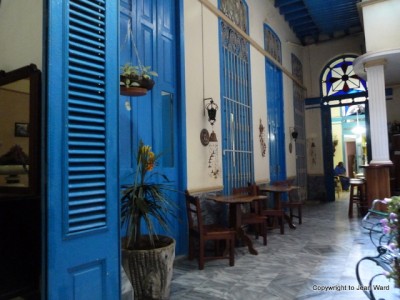
"Look at that one."
What make is it?"
"Did they really come out in that bright green?"
"At last a pink Cadillac."
For the first 3 days in Cuba we took numerous photos of Classic American cars. Stopping to look at them all until the novelty gradually wore off, there is more to Cuba than classic cars.
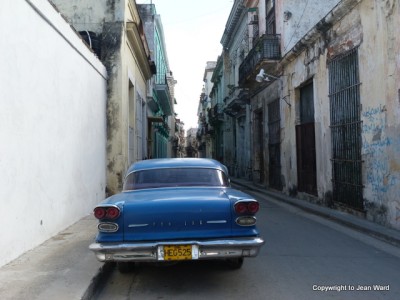
Friendly people, beautiful buildings, some crumbling some being restored, music, bumpy roads, comfortable tourist buses, blue water, lobsters, Che photos everywhere but none of Fidel, horse carts, bicitaxis, beggars, history, Hemmingway, cigars, proud poverty and much more. You really need to go and experience Cuba for yourself, I can only write about our experiences.
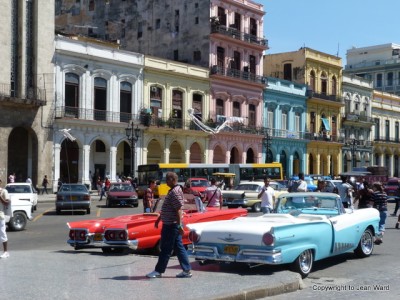
We arrived in Panamarina on a Friday and left for our trip the following Tuesday morning. A busy 4 days organising the boat, sourcing and booking flights and accommodation. By Sunday afternoon most of the booking was done which was lucky as the power at Panamarina went off just as I put the last load of washing in the dryer. No power for 24 hours also meant no internet. The only thing outstanding was confirmation of our Cubana Air flight out of Havana. That was a bit of a worry as we had been told that we needed that information to show immigration when we arrived at Havana, along with copies of our health insurance. As it turned out neither documents were asked for at Havana. No power for the printer to print all things needed for travelling including our boat papers so we can return to Panama without having an onward air ticket. Panamarina is not a true marina, the boats are on fore and aft moorings, which means rowing a few metres to shore and the office is shut Sunday and Monday which meant having to take our own printer ashore (our inverter is not working). Late Monday afternoon we noticed the dock light turn on...power at last. We loaded the printer and computer into the dinghy, paddled ashore and printed off everything including the Cubana ticket which popped into the In box just before the computer was turned off.
8am Tuesday morning our journey to La Habana began with a lift to shore by marina security, a 10 minute car ride to the bus stop, a 2 hour bus ride to Colon bus station where we had time for a quick snack before jumping on the bus to Panama city 3 hours away. The Colon bus station is not a place to linger so we were grateful that buses to Panama went every 30 minutes. $12US each for 5 hours of travel, not bad. We arrived at the huge Albrook bus terminal hungry and ready to stretch our legs. Lunch was easily found in the expansive food hall in the next door Mall. Probably one of the biggest food halls we have ever been in, I think there was every fast food known to the western world as well as many yet to make their name on the world stage. The long lanes of shops got the blood flowing through our legs while we searched for a shop to buy another camera. We eventually settled on a little Sony for those times when we didn't want to wave around the big camera. It has a nifty panoramic photo setting which we didn't realise until we got to the hotel, a setting that we have used quite alot on this trip. The last vehicle of the day was a taxi across town to our hotel, no energy left but to collapse on the bed and watch TV until dinner. The 6am alarm ding dong had been a long time ago and the alarm was set for 4.30am for the shuttle to the Panama, Tocumen airport.
Hunger drove us downstairs for dinner where we found out that the world in Central America had changed, Hugo Chavez the President of Venezuela had just died. The people at the bar were glued to the TV and the waitress told us very solemnly that Chavez had died. The next day while waiting for our change of plane in Costa Rico the TV s streamed the grief of Venezuala, outside flags flew at half mast. This was obviously a big deal in the region but in Cuba the death of their good friend had the fullest affect. The whole country was in official mourning, no music allowed anywhere. After a couple of days and talking to some Cubans we realised Cubans were worried, Chavez was the source of their oil, would his successor continue the support. The memory of the hungry years after the Soviet support pulled out, is fresh in minds of Cuba.

Cubans are poor some more than others and for a committed socialist country I was surprised at the number of beggars especially in Havana, doesn't socialism look after everyone, well apparently not. Whether you are a Doctor or a dish washer the difference in pay is very little, tourism jobs are better paid in that tips are available. Everyone earns between 20 and 30 CUC a month which is equal to the US$. Very little to live on even in low economy Cuba. Not surprisingly our guide in Vinales had given up being a teacher to walk people through the beautiful Vinales Valley. At 10CUC per person for our group of 4 he earned about a month and a half teacher salary in 4 hours. There are two money systems in Cuba, very simply, tourists have to use CUCs which are pegged to the US$, 1 to 1. Yes I know they don't like the US but it is very convenient to use the US$ as a currency indicator. Cubans use peso Cubanos which tourists are supposedly not meant to have but we had been advised to change about 10cuc, that got us 240 pesos, which lasted us for 10 days of lunches and a few tips for photos here and there. The Cubans want the CUCs so they can have access to more luxury items that are only sold in certain shops. Once we got our head around the money it was easy, hole in the wall restaurants produced 10 peso pizzas, meat and cheese sandwiches and guava juice for lunch, CUCs for everything else. Another separate currency seemed to be soap, except we were expected to produce it for free so that they could sell it on. We knew about this before we arrived and decided not to take part in this or any form of begging. With all that sorted we got on with the job of enjoying Cuba.
The Taxi from the airport delivered us to the door of our Casa Particular along the Prado in Havana, just on the edge of the old city.
"I hope this is ok, it looks a bit derelict."
I felt a bit like Alice as we stepped from one world into another. The derelict entrance way turned into a serene world of blue shutters, stained glass, cool tiles, an elegant lounge of piano and chandelier, rocking chairs and pot plants. Welcome to Alieda y Kenia our first Casa Particular. It seemed too good to be only 30CUC a night but no, we discovered that Casas ranged from 20 to 30 CUC a night throughout Cuba. A Casa Particular is a private house which has 2 or 3 rooms to let to tourists, they have to be registered and pay a set monthly tax whether or not they have guests. There are also hotels but for a close to the people experience the Casa is the way to go, we liked every Casa we stayed in and the people who ran them. Casa Carlos Colonial where we stayed in Trinidad was full of beautiful antiques, Manuel y Melbis at Cienfuegos was modern kitsch and potplants, Maria Luisa in Vinales was country with a touch of elegant antiques. All our rooms had ensuites so no walking around a strange home in the dark. Our Havana Casa was the most beautiful, the stained class windows above the 3 metre high interior doors were lovely examples of Cuban speciality known as vitrales. Tall blue wooden doors opened into blue and cream bedrooms. The 5 metre high stud was crowned by a matching blue wooden ceiling. The Casa is owned by Kenia a lively Cuban/German who conversed in a mix of Spanish/English and German and the more excited she got the more mixed it got. Although fun, the place achieved a more serene atmosphere when Kenia disappeared back to her other house and left us with the quietly efficient manager. We could use the elegant lounge but felt more at home using the rocking chairs and patting the cat in the tiled reception/dining area.
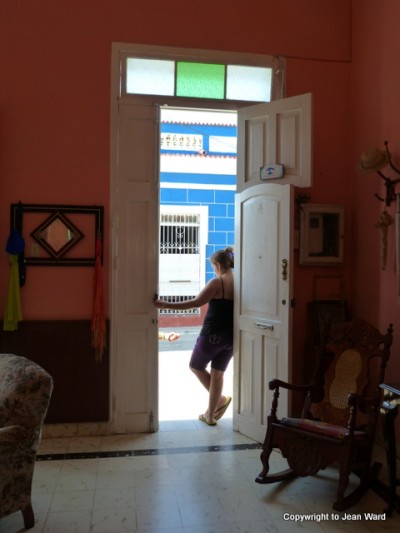
Food is always an interesting aspect of travelling, sourcing a variety of food in Cuba is obviously difficult , shops are virtually empty and although meals are big and of good quality there is a huge amount of meat and cheese on the menu. Lunch time sandwiches had a good amount of filling, the downside being it was just meat and cheese centimetres thick. The amount of filling we discarded would fill another sandwich. Evening meals consisted of big portions of meat or fish with rice and small amounts of vegetables. We chose to eat sandwiches and pizzas for lunch as two sit down meals a day was just too much. Breakfasts in the Casas were big enough to set you up for the day, a big plate of fresh fruit, the ever present guava juice, fresh bread and honey as well as eggs cooked in your favourite way. After three breakfasts in a row with eggs and meat sandwiches for lunch my stomach was complaining, something had to go. When I refused the eggs I had to harden my heart and think of my health rather than the disappointed look on the hosts faces. Most didn't seem to mind that I didnt want the ham with breakfast, but no eggs that was impossible, how could you get through the day without an egg for breakfast!
The best meals we had were in the Casa Particulares except for two restaurants, one in Havana and one in Cienfuegos. In the Casas we got three course dinners for 10cuc each, Manuel and Melbis served up soup and a huge grilled fish accompanied by potatoes and salad. They gave us a choice of rice or potatoes. Alan told them he would love potatoes as we had not had any for days and was missing his favourite vegetable. They took that on board and served potatoes done 3 ways!! We tried to refuse dessert, after all we had only managed half the fish, but we got ice cream anyway. The Blue Bahia restaurant at Cienfuegos served up another good meal accompanied by live piano music provided by their visiting Canadian friend.
The places to eat in Cuba for real Cuban food are in the Casa Particulares or in the family run Paladar. The Paladars started as family run restaurants in the front room or hall way of a home, just a few tables. Up until 1994 they were illegal, they then became legal and are now the best place to eat. There doesn't seem to be alot of them. Donna Blanquita, where we ate in Havana has spread out of the front room and on to the balcony giving a great view of the usually busy Prado. At Blue Bahia we knocked on the front door and were ushered into the front lounge which had been altered to fit in a bar and a place for the piano. We had a great evening at Donna Blanquita with Patrick and Amanda who were in Cuba on their yacht, Egret. They had great news, their crossing of the Atlantic without rudder had won them two prestigious yachting awards in England. They had also given us a little mention in the article they have had published in the Ocean Cruising Club magazine which has one of my photos of the mid ocean diesel transfer on the front cover.
We booked our first 3 nights in Havana through www.casaparticularcuba.org , Leo has several hundred Cuban Casas on his books, we looked through the site and selected one. That one was booked so he booked us into the delightful Alieda y Kenia. The first morning in Havana Leo came to see us and spent half an hour making sure we knew about the money system, how to get around, prices to pay and left us with a list of his contacts throughout Cuba. A fantastic service along with the pre arrival email he sent us full of information such as the cost of taxi from the airport, he also suggested bringing some clothes in our hand luggage as, "sometimes (not always) luggage to Cuba can get delayed, especially if getting connecting flights." Happily ours arrived with us. When we moved on to Cienfuegos we rang the next person on the list and he sorted out our accommodation. In that way we got passed around from Casa to Casa. Cuba is a network of families and friends, someone always knows someone with the service you want even if it is at the other end of the country.
We mainly travelled by bus between places. The buses are modern comfortable coaches, called tourist buses in Cuba as only tourists can travel in them and tourist cannot travel in local buses. Some of the roads away from the main highway are not the best so well sprung seats are a necessity. Rental cars are from $70 CUC a day and up so just for two that is an expensive way to travel and the bus system is so reasonable and easy, hiring a car is not necessary. We did travel the 80 kms from Cienfuegos to Trinidad in a 1951 Chysler Van. We asked our host about getting a taxi to Trinidad so we could stop along the way so of course he had a friend who turned up the next day with his taxi. Well he had a taxi sign in the window but I am not sure if he was legal as he drove very carefully past the few police posts we saw along the way. As it turned out there wasn't really anything that great to see along the way, don't believe everything you read!!! We enjoyed the journey and got him to stop to pick up a couple of hitch hikers. A mother and her little boy who went nearly all the way to Trinidad with us. Hitch hiking is very common thing for Cubans to do, there is not a lot of traffic on the road so some must have to wait a long time for a ride. We said we could pick up more but our driver seemed to think two was enough.
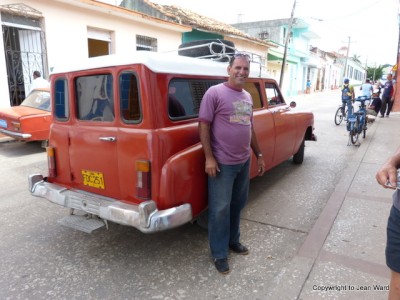
Trinidad is a delightful town despite the tourist feel to it. The town is one of the tourist jewels of Cuba. By the time we got to Cienfuegos, music was starting to make a comeback and by Trinidad the air was full of it again. In Trinidad we met some other New Zealanders and got to know Angela and Tony from the English sailing vessel Tana Vika. More of that in Part Two.
What make is it?"
"Did they really come out in that bright green?"
"At last a pink Cadillac."
For the first 3 days in Cuba we took numerous photos of Classic American cars. Stopping to look at them all until the novelty gradually wore off, there is more to Cuba than classic cars.

Friendly people, beautiful buildings, some crumbling some being restored, music, bumpy roads, comfortable tourist buses, blue water, lobsters, Che photos everywhere but none of Fidel, horse carts, bicitaxis, beggars, history, Hemmingway, cigars, proud poverty and much more. You really need to go and experience Cuba for yourself, I can only write about our experiences.

We arrived in Panamarina on a Friday and left for our trip the following Tuesday morning. A busy 4 days organising the boat, sourcing and booking flights and accommodation. By Sunday afternoon most of the booking was done which was lucky as the power at Panamarina went off just as I put the last load of washing in the dryer. No power for 24 hours also meant no internet. The only thing outstanding was confirmation of our Cubana Air flight out of Havana. That was a bit of a worry as we had been told that we needed that information to show immigration when we arrived at Havana, along with copies of our health insurance. As it turned out neither documents were asked for at Havana. No power for the printer to print all things needed for travelling including our boat papers so we can return to Panama without having an onward air ticket. Panamarina is not a true marina, the boats are on fore and aft moorings, which means rowing a few metres to shore and the office is shut Sunday and Monday which meant having to take our own printer ashore (our inverter is not working). Late Monday afternoon we noticed the dock light turn on...power at last. We loaded the printer and computer into the dinghy, paddled ashore and printed off everything including the Cubana ticket which popped into the In box just before the computer was turned off.
8am Tuesday morning our journey to La Habana began with a lift to shore by marina security, a 10 minute car ride to the bus stop, a 2 hour bus ride to Colon bus station where we had time for a quick snack before jumping on the bus to Panama city 3 hours away. The Colon bus station is not a place to linger so we were grateful that buses to Panama went every 30 minutes. $12US each for 5 hours of travel, not bad. We arrived at the huge Albrook bus terminal hungry and ready to stretch our legs. Lunch was easily found in the expansive food hall in the next door Mall. Probably one of the biggest food halls we have ever been in, I think there was every fast food known to the western world as well as many yet to make their name on the world stage. The long lanes of shops got the blood flowing through our legs while we searched for a shop to buy another camera. We eventually settled on a little Sony for those times when we didn't want to wave around the big camera. It has a nifty panoramic photo setting which we didn't realise until we got to the hotel, a setting that we have used quite alot on this trip. The last vehicle of the day was a taxi across town to our hotel, no energy left but to collapse on the bed and watch TV until dinner. The 6am alarm ding dong had been a long time ago and the alarm was set for 4.30am for the shuttle to the Panama, Tocumen airport.
Hunger drove us downstairs for dinner where we found out that the world in Central America had changed, Hugo Chavez the President of Venezuela had just died. The people at the bar were glued to the TV and the waitress told us very solemnly that Chavez had died. The next day while waiting for our change of plane in Costa Rico the TV s streamed the grief of Venezuala, outside flags flew at half mast. This was obviously a big deal in the region but in Cuba the death of their good friend had the fullest affect. The whole country was in official mourning, no music allowed anywhere. After a couple of days and talking to some Cubans we realised Cubans were worried, Chavez was the source of their oil, would his successor continue the support. The memory of the hungry years after the Soviet support pulled out, is fresh in minds of Cuba.

Cubans are poor some more than others and for a committed socialist country I was surprised at the number of beggars especially in Havana, doesn't socialism look after everyone, well apparently not. Whether you are a Doctor or a dish washer the difference in pay is very little, tourism jobs are better paid in that tips are available. Everyone earns between 20 and 30 CUC a month which is equal to the US$. Very little to live on even in low economy Cuba. Not surprisingly our guide in Vinales had given up being a teacher to walk people through the beautiful Vinales Valley. At 10CUC per person for our group of 4 he earned about a month and a half teacher salary in 4 hours. There are two money systems in Cuba, very simply, tourists have to use CUCs which are pegged to the US$, 1 to 1. Yes I know they don't like the US but it is very convenient to use the US$ as a currency indicator. Cubans use peso Cubanos which tourists are supposedly not meant to have but we had been advised to change about 10cuc, that got us 240 pesos, which lasted us for 10 days of lunches and a few tips for photos here and there. The Cubans want the CUCs so they can have access to more luxury items that are only sold in certain shops. Once we got our head around the money it was easy, hole in the wall restaurants produced 10 peso pizzas, meat and cheese sandwiches and guava juice for lunch, CUCs for everything else. Another separate currency seemed to be soap, except we were expected to produce it for free so that they could sell it on. We knew about this before we arrived and decided not to take part in this or any form of begging. With all that sorted we got on with the job of enjoying Cuba.
The Taxi from the airport delivered us to the door of our Casa Particular along the Prado in Havana, just on the edge of the old city.
"I hope this is ok, it looks a bit derelict."
I felt a bit like Alice as we stepped from one world into another. The derelict entrance way turned into a serene world of blue shutters, stained glass, cool tiles, an elegant lounge of piano and chandelier, rocking chairs and pot plants. Welcome to Alieda y Kenia our first Casa Particular. It seemed too good to be only 30CUC a night but no, we discovered that Casas ranged from 20 to 30 CUC a night throughout Cuba. A Casa Particular is a private house which has 2 or 3 rooms to let to tourists, they have to be registered and pay a set monthly tax whether or not they have guests. There are also hotels but for a close to the people experience the Casa is the way to go, we liked every Casa we stayed in and the people who ran them. Casa Carlos Colonial where we stayed in Trinidad was full of beautiful antiques, Manuel y Melbis at Cienfuegos was modern kitsch and potplants, Maria Luisa in Vinales was country with a touch of elegant antiques. All our rooms had ensuites so no walking around a strange home in the dark. Our Havana Casa was the most beautiful, the stained class windows above the 3 metre high interior doors were lovely examples of Cuban speciality known as vitrales. Tall blue wooden doors opened into blue and cream bedrooms. The 5 metre high stud was crowned by a matching blue wooden ceiling. The Casa is owned by Kenia a lively Cuban/German who conversed in a mix of Spanish/English and German and the more excited she got the more mixed it got. Although fun, the place achieved a more serene atmosphere when Kenia disappeared back to her other house and left us with the quietly efficient manager. We could use the elegant lounge but felt more at home using the rocking chairs and patting the cat in the tiled reception/dining area.

Food is always an interesting aspect of travelling, sourcing a variety of food in Cuba is obviously difficult , shops are virtually empty and although meals are big and of good quality there is a huge amount of meat and cheese on the menu. Lunch time sandwiches had a good amount of filling, the downside being it was just meat and cheese centimetres thick. The amount of filling we discarded would fill another sandwich. Evening meals consisted of big portions of meat or fish with rice and small amounts of vegetables. We chose to eat sandwiches and pizzas for lunch as two sit down meals a day was just too much. Breakfasts in the Casas were big enough to set you up for the day, a big plate of fresh fruit, the ever present guava juice, fresh bread and honey as well as eggs cooked in your favourite way. After three breakfasts in a row with eggs and meat sandwiches for lunch my stomach was complaining, something had to go. When I refused the eggs I had to harden my heart and think of my health rather than the disappointed look on the hosts faces. Most didn't seem to mind that I didnt want the ham with breakfast, but no eggs that was impossible, how could you get through the day without an egg for breakfast!
The best meals we had were in the Casa Particulares except for two restaurants, one in Havana and one in Cienfuegos. In the Casas we got three course dinners for 10cuc each, Manuel and Melbis served up soup and a huge grilled fish accompanied by potatoes and salad. They gave us a choice of rice or potatoes. Alan told them he would love potatoes as we had not had any for days and was missing his favourite vegetable. They took that on board and served potatoes done 3 ways!! We tried to refuse dessert, after all we had only managed half the fish, but we got ice cream anyway. The Blue Bahia restaurant at Cienfuegos served up another good meal accompanied by live piano music provided by their visiting Canadian friend.
The places to eat in Cuba for real Cuban food are in the Casa Particulares or in the family run Paladar. The Paladars started as family run restaurants in the front room or hall way of a home, just a few tables. Up until 1994 they were illegal, they then became legal and are now the best place to eat. There doesn't seem to be alot of them. Donna Blanquita, where we ate in Havana has spread out of the front room and on to the balcony giving a great view of the usually busy Prado. At Blue Bahia we knocked on the front door and were ushered into the front lounge which had been altered to fit in a bar and a place for the piano. We had a great evening at Donna Blanquita with Patrick and Amanda who were in Cuba on their yacht, Egret. They had great news, their crossing of the Atlantic without rudder had won them two prestigious yachting awards in England. They had also given us a little mention in the article they have had published in the Ocean Cruising Club magazine which has one of my photos of the mid ocean diesel transfer on the front cover.
We booked our first 3 nights in Havana through www.casaparticularcuba.org , Leo has several hundred Cuban Casas on his books, we looked through the site and selected one. That one was booked so he booked us into the delightful Alieda y Kenia. The first morning in Havana Leo came to see us and spent half an hour making sure we knew about the money system, how to get around, prices to pay and left us with a list of his contacts throughout Cuba. A fantastic service along with the pre arrival email he sent us full of information such as the cost of taxi from the airport, he also suggested bringing some clothes in our hand luggage as, "sometimes (not always) luggage to Cuba can get delayed, especially if getting connecting flights." Happily ours arrived with us. When we moved on to Cienfuegos we rang the next person on the list and he sorted out our accommodation. In that way we got passed around from Casa to Casa. Cuba is a network of families and friends, someone always knows someone with the service you want even if it is at the other end of the country.
We mainly travelled by bus between places. The buses are modern comfortable coaches, called tourist buses in Cuba as only tourists can travel in them and tourist cannot travel in local buses. Some of the roads away from the main highway are not the best so well sprung seats are a necessity. Rental cars are from $70 CUC a day and up so just for two that is an expensive way to travel and the bus system is so reasonable and easy, hiring a car is not necessary. We did travel the 80 kms from Cienfuegos to Trinidad in a 1951 Chysler Van. We asked our host about getting a taxi to Trinidad so we could stop along the way so of course he had a friend who turned up the next day with his taxi. Well he had a taxi sign in the window but I am not sure if he was legal as he drove very carefully past the few police posts we saw along the way. As it turned out there wasn't really anything that great to see along the way, don't believe everything you read!!! We enjoyed the journey and got him to stop to pick up a couple of hitch hikers. A mother and her little boy who went nearly all the way to Trinidad with us. Hitch hiking is very common thing for Cubans to do, there is not a lot of traffic on the road so some must have to wait a long time for a ride. We said we could pick up more but our driver seemed to think two was enough.

Trinidad is a delightful town despite the tourist feel to it. The town is one of the tourist jewels of Cuba. By the time we got to Cienfuegos, music was starting to make a comeback and by Trinidad the air was full of it again. In Trinidad we met some other New Zealanders and got to know Angela and Tony from the English sailing vessel Tana Vika. More of that in Part Two.
Comments
| Vessel Name: | Tuatara |
| Vessel Make/Model: | Alan Wright 51 |
| Hailing Port: | Opua NZ |
| Crew: | Alan and Jean Ward |
Gallery not available
Sailing in the Pacific
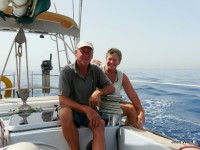
Who: Alan and Jean Ward
Port: Opua NZ

